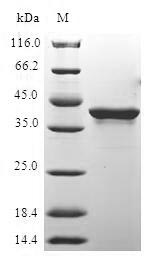Recombinant Human Histone H2A.x (H2AFX) is produced in E. coli and includes the complete protein sequence spanning amino acids 1 to 143. The protein carries an N-terminal GST tag that helps with purification and detection processes. SDS-PAGE analysis confirms the product maintains purity levels above 90%, which appears to support reliable research outcomes. This protein is designed strictly for research purposes and should not be used in diagnostic or therapeutic applications.
Histone H2A.x represents a variant within the histone H2A family and seems to play an essential role in how cells respond to and repair DNA damage. When DNA sustains damage, H2A.x undergoes phosphorylation and likely helps recruit repair proteins to the damaged sites. This involvement in protecting genomic integrity makes it particularly valuable for research into cell cycle control and cancer studies.
Potential Applications
Note: The applications listed below are based on what we know about this protein's biological functions, published research, and experience from experts in the field. However, we haven't fully tested all of these applications ourselves yet. We'd recommend running some preliminary tests first to make sure they work for your specific research goals.
Human H2AFX is a core histone variant that forms the nucleosome structure. Histones are relatively small, highly basic proteins that typically fold correctly in E. coli expression systems due to their conserved histone fold domain. The GST tag may affect the N-terminal structure but is unlikely to prevent overall folding. Therefore, this recombinant protein has a high probability of correct folding. However, its activity in nucleosome assembly depends on proper folding and interaction with other histones.
1. Chromatin Remodeling and Nucleosome Assembly Studies
This recombinant H2AFX is suitable for nucleosome reconstitution assays when combined with other core histones (H2B, H3, H4) and DNA. The GST tag may need to be removed (via protease cleavage) to avoid steric hindrance during nucleosome assembly. If properly folded, it can replace canonical H2A in nucleosomes to study H2AFX-specific effects on chromatin structure and stability. It is strongly recommended to verify the protein folding via circular dichroism before experimenting.
2. GST Pull-Down Assays for Protein-Protein Interaction Studies
The GST tag enables direct use in pull-down assays to identify H2AFX-binding partners (e.g., DNA repair proteins, chromatin remodelers). The high purity (>90%) minimizes non-specific binding. However, interactions may be influenced by the GST tag or lack of nucleosome context. Validate the protein folding via circular dichroism and activity via nucleosome reconstitution assays before experimenting.
3. Antibody Development and Validation
This protein is an excellent immunogen for generating H2AFX-specific antibodies. The full-length sequence ensures coverage of linear and conformational epitopes. The GST tag can be used for purification and screening.
4. In Vitro Histone Modification Assays
This protein can serve as a substrate for kinase assays (e.g., ATM/ATR-mediated phosphorylation at Ser139/γH2AX) and other PTM studies. The GST tag may affect enzyme accessibility to modification sites. Validate activity via nucleosome reconstitution assays before performing this experiment.




